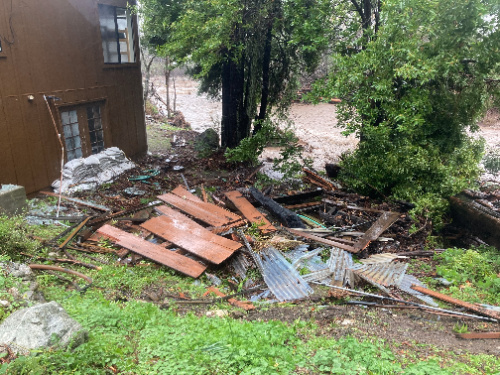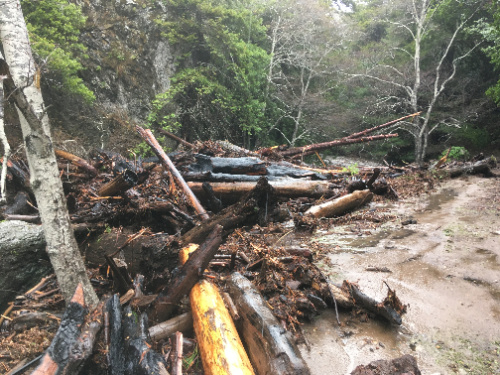Campus News
Massive debris flow swamps Big Creek Reserve as heavy rains follow summer wildfire
Boulders the size of vehicles and decades-old redwoods were ripped from the banks of the Big Creek drainage when an atmospheric river inundated the Landels-Hill Big Creek Natural Reserve on the Big Sur coast in late January.





Boulders the size of vehicles and decades-old redwoods were ripped from the banks of the Big Creek drainage when an atmospheric river inundated the Landels-Hill Big Creek Natural Reserve on the Big Sur coast in late January.
More than 14 inches fell in two bouts in a 50-hour period between Jan. 26 and Jan. 28, Big Creek Reserve manager Mark Readdie said. Rainfall on the ridgetops could have been even higher but it’s not known because the Dolan Fire destroyed a National Weather Service weather station last August as it swept across the reserve’s 8,000 acres that UC Santa Cruz manages as part of the UC Natural Reserve system.
The fire left hillsides stripped of vegetation and created a lot of loose soil and hazard trees, Readdie said. Once the rain hit the soil began to move. Essentially the hills melted.
Geologists are investigating exactly what happened. Readdie said they don’t know whether there was a single large landslide in the Big Creek drainage or multiple slides across the 16 square miles of watershed. In any case, a huge amount of material and a lot of force — a high-flow event — struck the watershed and rumbled toward the coast.
In a note to his colleagues Jan. 30, Readdie called it a “mass-wasting event” somewhere up the Big Creek fork.
Logs that had been in the creek channel for decades began to move, formed a logjam and then burst free the night of Jan. 27 or early Jan. 28, Readdie said.
Along the way, logs and debris removed trees and boulders from the creek bank. At one point the water looked to be nearly 20 feet above the past creek bed level. The canyon road in several places is buried in debris, inundated with water, or damaged, Readdie reported.
The cove at the coast, once 12 to 15 feet deep and filled with kelp, is now a beach filled with gravel and sediment.
The same storm and same physics washed out Highway 1 at Rat Creek just two miles north of the Big Creek Reserve, cutting off access from the north.
If there is a silver lining, Readdie said: “We got hit with the fire, we got hit with the flood. The amazing thing is we skipped having our facilities damaged.” One structure was lost — the shower between the Gatehouse and the creek was crushed by logs.
The task now for Readdie and the five other Big Creek Reserve staff members is to deal with infrastructure repair, get potable water back in operation, repair communications systems, and “get access back to our roads,” he said.
Though staff and firefighters were able to protect the reserve’s buildings when the wildfire hit six months ago it destroyed the campground where groups of students would stay, and some above-ground water pipes were burned. The flood then finished the job, ripping out pipes, wrapping some around trees.
Big Creek Reserve is a research station, a classroom, and a laboratory. Its guiding principle is to contribute to the understanding of ecological processes as they occur and to provide a benchmark for interpreting long-term environmental change.
Without question, Big Creek is experiencing environmental change. “Big impacts define the landscape,” said Readdie, who obtained his undergrad and Ph.D at UC Santa Cruz and who has managed the reserve since 2007. “We had a big fire and a massive hydrological event.” Scientists continue to study the effects of the fire, now they will also study the geology.
Big Creek continues to inspire, Readdie said, but the big question now is what is the new normal as nature takes its course. How to facilitate research and teaching while preserving the ecological integrity of the reserve. From an operational view, the canyon road is not usable, portions of an interpretive trail are gone. What will be repaired and what will be allowed to remain as is?